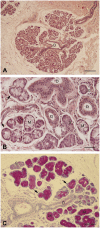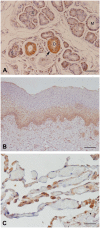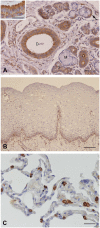Immunolocalization of Surfactant Proteins SP-A, SP-B, SP-C, and SP-D in Infantile Labial Glands and Mucosa
- PMID: 29601229
- PMCID: PMC6055263
- DOI: 10.1369/0022155418766063
Immunolocalization of Surfactant Proteins SP-A, SP-B, SP-C, and SP-D in Infantile Labial Glands and Mucosa
Abstract
Surfactant proteins in different glandular structures of the oral cavity display antimicrobial activity for protection of invading microorganisms. Moreover, they are involved in lowering liquid tension in fluids and facilitate secretion flows. Numerous investigations for studying the occurrence of surfactant proteins in glandular tissues were performed using different methods. In the oral cavity, minor salivary glands secrete saliva continuously for the maintenance of a healthy oral environment. For the first time, we could show that infantile labial glands show expression of the surfactant proteins (SP) SP-A, SP-B, SP-C, and SP-D in acinar cells and the duct system in different intensities. The stratified squamous epithelium of the oral mucosa revealed positive staining for SPs in various cell layers.
Keywords: human labial gland; immunohistochemistry; minor salivary gland; surfactant proteins.
Conflict of interest statement
Figures





Similar articles
-
Immunolocalization of surfactant protein A and D in sinonasal mucosa.Am J Rhinol. 2006 Jul-Aug;20(4):461-5. doi: 10.2500/ajr.2006.20.2892. Am J Rhinol. 2006. PMID: 16955780
-
Expression and localization of surfactant proteins in human nasal epithelium.Am J Physiol Lung Cell Mol Physiol. 2007 Apr;292(4):L879-84. doi: 10.1152/ajplung.00156.2006. Epub 2007 Jan 5. Am J Physiol Lung Cell Mol Physiol. 2007. PMID: 17209137
-
Surfactant proteins A, B, C and D in the human nasal airway: associated with mucosal glands and ciliated epithelium but absent in fluid-phase secretions and mucus.ORL J Otorhinolaryngol Relat Spec. 2014;76(5):288-301. doi: 10.1159/000369143. Epub 2014 Dec 10. ORL J Otorhinolaryngol Relat Spec. 2014. PMID: 25500788
-
Surfactant proteins SP-A and SP-D in human health and disease.Arch Immunol Ther Exp (Warsz). 2005 Sep-Oct;53(5):399-417. Arch Immunol Ther Exp (Warsz). 2005. PMID: 16314824 Review.
-
New synthetic surfactants: the next generation?Biol Neonate. 2005;87(4):338-44. doi: 10.1159/000084882. Epub 2005 Jun 1. Biol Neonate. 2005. PMID: 15985757 Review.
Cited by
-
Association of Surfactant Protein D Single Nucleotide Polymorphisms rs721917, rs2243639, rs3088308 with Recurrent Aphthous Stomatitis in Pakistani Population.Genes (Basel). 2023 May 22;14(5):1119. doi: 10.3390/genes14051119. Genes (Basel). 2023. PMID: 37239479 Free PMC article.
-
Different expression of circulating microRNA profile and plasma SP-D in Tibetan COPD patients.Sci Rep. 2022 Mar 1;12(1):3388. doi: 10.1038/s41598-022-05592-2. Sci Rep. 2022. PMID: 35232961 Free PMC article.
-
Surfactant Protein A and Microbiome Composition in Patients With Atraumatic Intraoral Lesions.Front Oral Health. 2021 Apr 22;2:663483. doi: 10.3389/froh.2021.663483. eCollection 2021. Front Oral Health. 2021. PMID: 35048007 Free PMC article.
References
-
- Liley HG, Ertsey R, Gonzales LW, Odom MW, Hawgood S, Dobbs LG, Ballard PL. Synthesis of surfactant components by cultured type II cells from human lung. Biochim Biophys Acta. 1988;961(1):86–95. - PubMed
-
- Goerke J. Pulmonary surfactant: functions and molecular composition. Biochim Biophys Acta. 1998;1408(2–3):79–89. - PubMed
-
- McCormack FX. Structure, processing and properties of surfactant protein A. Biochim Biophys Acta. 1998;1408(2–3):109–31. - PubMed
-
- Pikaar JC, Voorhout WF, van Golde LM, Verhoef J, van Strijp JA, van Iwaarden JF. Opsonic activities of surfactant proteins A and D in phagocytosis of gram-negative bacteria by alveolar macrophages. J Infect Dis. 1995;172(2):481–9. - PubMed
-
- Mariencheck WI, Savov J, Dong Q, Tino MJ, Wright JR. Surfactant protein A enhances alveolar macrophage phagocytosis of a live, mucoid strain of P. aeruginosa. Am J Physiol. 1999;277(4, Pt 1):L777–86. - PubMed
MeSH terms
Substances
LinkOut - more resources
Full Text Sources
Other Literature Sources

